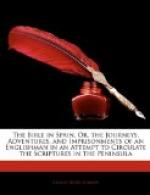“A handless man a letter did write,
A dumb dictated it word for word:
The person who read it had lost his sight,
And deaf was he who listened and heard.”
Early the next morning we emerged from the hollow of Luarca; about an hour’s riding brought us to Caneiro, a deep and romantic valley of rocks, shaded by tall chestnut trees. Through the midst of this valley rushes a rapid stream, which we crossed in a boat. “There is not such a stream for trout in all the Asturias,” said the ferryman; “look down into the waters and observe the large stones over which it flows; now in the proper season and in fine weather, you cannot see those stones for the multitude of fish which cover them.”
Leaving the valley behind us, we entered into a wild and dreary country, stony and mountainous. The day was dull and gloomy, and all around looked sad and melancholy. “Are we in the way for Giyon and Oviedo?” demanded Martin of an ancient female, who stood at the door of a cottage.
“For Giyon and Oviedo!” replied the crone; “many is the weary step you will have to make before you reach Giyon and Oviedo. You must first of all crack the bellotas: you are just below them.”
“What does she mean by cracking the bellotas?” demanded I of Martin of Rivadeo.
“Did your worship never hear of the seven bellotas?” replied our guide. “I can scarcely tell you what they are, as I have never seen them; I believe they are seven hills which we have to cross, and are called bellotas from some resemblance to acorns which it is fancied they bear. I have often heard of these acorns, and am not sorry that I have now an opportunity of seeing them, though it is said that they are rather hard things for horses to digest.”
The Asturian mountains in this part rise to a considerable altitude. They consist for the most part of dark granite, covered here and there with a thin layer of earth. They approach very near to the sea, to which they slope down in broken ridges, between which are deep and precipitous defiles, each with its rivulet, the tribute of the hills to the salt flood. The road traverses these defiles. There are seven of them, which are called, in the language of the country, Las siete bellotas. Of all these, the most terrible is the midmost, down which rolls an impetuous torrent. At the upper end of it rises a precipitous wall of rock, black as soot, to the height of several hundred yards; its top, as we passed, was enveloped with a veil of bretima. From this gorge branch off, on either side, small dingles or glens, some of them so overgrown with trees and copse-wood, that the eye is unable to penetrate the obscurity beyond a few yards.
“Fine places would some of these dingles prove for hermitages,” said I to Martin of Rivadeo. “Holy men might lead a happy life there on roots and water, and pass many years absorbed in heavenly contemplation, without ever being disturbed by the noise and turmoil of the world.”




